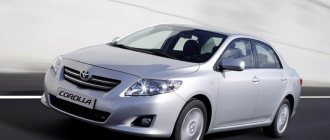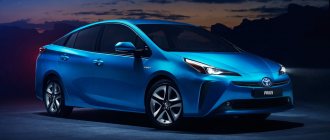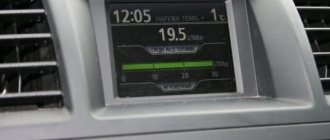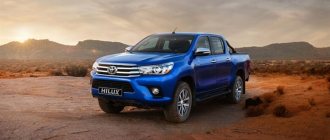Toyota Corolla is a Japanese-made car, produced since 1966. Initially it belonged to the subcompact class, and since 1967 it has been positioned as a larger car of the compact class. From generation to generation, Corolla increases in size and becomes more spacious. In 2006, Toyota celebrated the 60th anniversary of the model - during which time eleven generations of the car were released. In 2013, the 40 millionth Toyota Corolla was produced. The machine is in high demand all over the world. The car is available in a sedan body, and the hatchback version is called Auris.
Factors affecting fuel consumption
The most popular among Russian motorists are gasoline engines with a volume of 1.6 and 1.5 liters; using their example, we will consider the fuel consumption of these power units. Gasoline consumption is directly dependent on the following factors:
- Engine power - the more horsepower the engine has, the more fuel consumption, naturally.
- Engine temperature – on a poorly warmed-up engine, consumption increases by an average of 1–2 liters.
- Driving style - aggressive driving style, sudden starts at traffic lights and unnecessary braking and acceleration increase gasoline consumption by 1.5 times.
- The weight of the car - obviously, the more you load the car, the more gasoline the engine consumes per kilometer of travel.
- Air conditioning - this unit, turned on at full power, especially in hot weather, increases the load on the engine and contributes to increased fuel consumption (by more than 10%).
- Wheel width - the wider the tires on the car's rims, the greater the rolling resistance and the higher the fuel consumption.
- Car maintenance - a timely inspection by specialists, their feedback on the technical condition of the car will help to detect defects that affect gasoline consumption.
- Drive type - a car with all-wheel drive is characterized by increased fuel consumption (increases by approximately one liter).
E160
Hyundai accent fuel consumption owner reviews
The eleventh generation (E160), released in 2012, is distinguished by a more modest choice of engines. There is only one diesel engine left - 1.4 liter, the same power and only with a manual gearbox. Its consumption decreased to 4 liters. The gasoline range is represented by a 1.3-liter unit that developed power up to 99 hp. and had a manual transmission, a 1.6 liter engine producing 122 hp. and controlled by a CVT or a six-speed manual, as well as a 1.8 liter unit with 140 horsepower and a CVT. Their gasoline consumption remained the same. For the station wagon, a hybrid engine was added, producing 74 horsepower with a volume of 1.5 liters. Fuel consumption – 2.9 liters.
Now a restyled version of this variation (E170), released in 2015, is being produced. Gasoline engines remained unchanged here, and diesel engines ceased to be used altogether.
Fuel consumption data
For the Toyota Corolla, its fuel consumption per 100 km also depends on what transmission is installed on the car.
The data below indicates the fuel consumption stated in the vehicle specifications.
| Consumption in liters | Manual transmission | Automatic transmission | Variable speed drive |
| City | 8.9 | 9.3 | 8.2 |
| Route | 5.8 | 6.0 | 5.3 |
| City/highway | 6.9 | 7.2 | 6.3 |
The table shows that the Corolla 1.6 manual in the 140/150 body consumes slightly less fuel than the engine of a 1.6 automatic car, and the Toyota Corolla's fuel consumption (multistage CVT) is 7% lower than that of the Toyota Corolla 1.6 automatic.
E140
Fuel consumption Hyundai Solaris: 1.4-1.6 + owner reviews
The tenth generation (E140), which appeared in our country in 2007, has lost half of the available bodies. Now it is only a sedan and a station wagon. The engines installed here were of the same size, but some of them changed slightly in characteristics. The 1.3-liter gasoline unit was boosted to 101 horsepower, removing the possibility of installing an automatic transmission. The one and a half liter engine also lost this transmission, receiving a CVT instead. The 1.6-liter engine was raised to 124 horsepower.
The only change for the 1.8 liter version is that a CVT has become available. The two-liter diesel engine was boosted to 126 horsepower. An automatic transmission was added to the 1.4 liter unit. The station wagon could only boast petrol engines of 1.5 (110 hp) and 1.8 (136 hp) liters. They were strictly CVT and could have either front-wheel drive or all-wheel drive.
The restyling of this generation (E150) brought only one new configuration for the 1.8 liter engine. Its power was 144 horsepower. It was controlled by a variator, and it consumed 7.3 liters of fuel.
All-wheel drive engines
All-wheel drive on the Toyota Corolla 1.5 was mainly based on the Filder modification from 1996 in the E120 body and the 11th generation restyled model with a CVT. The highest fuel consumption for all-wheel drive was an average of 10.2 liters, for an engine with a CVT – 9.3 liters. If you look at every review from owners of cars of 2005, 2006, 2008 and later models, the actual consumption is a bit high (one and a half liters higher).
But still, with such fuel consumption, the Toyota Corolla 1.6 remains one of the most economical modern cars in the world.
Interior
The interior of the new Corolla does not surprise with its newfangled design solutions.
However, all parts are made of high-quality plastic and fit perfectly. The steering wheel is covered in leather and has a classic three-beam design. Multimedia control keys are built into the horizontal beams, and the vertical one is decorated with a decorative aluminum-look insert.
The classic instrument panel boasts a large on-board computer display and LED backlighting. The center console only looks good when equipped. The air ducts shifted towards the driver and the faded climate control system are saved only by the large display of the multimedia system with a built-in navigation system. The polished plastic around the screen quickly gets dirty and becomes covered with a web of scratches.
The seats are comfortable, there are enough adjustment modes. Rear row passengers have plenty of legroom, but tall people sometimes touch their heads to the ceiling.
The car is equipped with all modern systems: airbags, brake force redistribution system, parking sensors, powerful music station, full power accessories, heated seats.
Features of operation in winter
Many motorists are faced with the problem of high fuel consumption in winter. Almost every review from car owners says that fuel consumption increases in winter, especially for cars with high mileage. To reduce gasoline costs during the cold season, try to follow these rules:
- Before the onset of cold weather, check the condition of the chassis at a service station and adjust the power and ignition systems. Change the spark plugs yourself to new ones - this will save 5% of fuel.
- To reduce your Toyota Corolla's fuel consumption, change the dirty filter, which prevents the formation of a normal fuel-air mixture to maintain optimal engine performance, requiring a lot of gasoline.
- If your car has high gas mileage, fill in 5W30 synthetic oils in winter - low viscosity makes the engine easier to operate and reduces costs.
- In winter, when the air conditioning, heater and headlights are on, fuel is consumed by 20% more, and you need to know this when driving long distances at night and in cold weather.
- Before each trip on your Corolla 150, warm up the engine well; unheated oil does not penetrate into all cavities of the engine; it operates in a critical mode, threatening the failure of some components, which increases consumption by 8%.
- When you get stuck in a traffic jam, do not turn off the engine every time - frequent starts consume much more gasoline than when the engine is constantly running.
- In a Toyota Corolla, high fuel consumption can be reduced by driving smoothly and measuredly; if you get stuck in the snow, do not accelerate or turn the steering wheel; thoughtful and unhurried actions help save fuel.
- If you look at every review from car owners of cars 2005, 2006, 2008 and other models, wide and insufficiently inflated tires on snowy surfaces increase fuel consumption by 10%.
The influence of the installed air conditioner and the width of the car wheels
There is an opinion that air conditioners in cars do not in any way affect the overall fuel consumption. But, as it turns out from experience, this is absolutely not the case. If the air conditioner is turned on at full power during the hottest time, then fuel consumption begins to increase by approximately 10%. What is the reason for this? When the air conditioner turns on, there is additional load on the engine. And the more the engine is loaded, the more fuel it will consume.
READ MORE: Toyota Corolla dashboard
If a car has wide wheels, then more aerodynamic drag is created than with narrow wheels. For this reason, fuel consumption increases. Therefore, it is better not to change the width. Let the one supplied by the manufacturer remain.
Modification 1.4 MT+AT
This type of engine is not as common as the 1.3-liter power unit. For the first time, this engine was equipped with the eighth generation Toyota Corolla after restyling. A few years later, the famous Toyota Corolla E120 and E130 acquired powerful, 97-horsepower engines. The line of power units also includes a turbodiesel version of the 1.4-liter engine, which is equipped with the “Japanese” Elegance and Classic trim levels. Fuel consumption is 8.5 liters and 5.8 liters per 100 km. As for the turbodiesel version, here the “appetites” are more modest – 6 liters and 4.5 liters per 100 km traveled.
Owners of the modification leave the following indicators of fuel consumption by the car:
- Sergey, Armavir. The car is simply incredibly economical. Sometimes it takes me 4 liters on the highway - this is in a Toyota Corolla with a 1.4 diesel engine. As for the “appetite” within the city, here the maximum I had was 7 liters. In general, a very reliable engine, the mechanics work properly, I recommend it to everyone!
- Stas, Pyatigorsk. I've been driving my Toyota Corolla E120 since 2005. During this time, I have no complaints about this car. What I like about this car is its excellent dynamics and low gasoline consumption - 8.8 liters in the city and 6 liters on the highway.
- Alexander, Maykop. A good family car that I have been driving since 2011. This is an excellent choice for those who like to go on vacation with the whole family, travel every day on business, and periodically travel long distances. Indeed, in addition to reliability and prestige, the owner of a Toyota Corolla also receives relatively low gasoline consumption - 8.6 liters and 6.2 liters city/highway, respectively.
- Albert, Shchelkovo. If you drive calmly and according to the rules, then it is quite possible to achieve gasoline consumption by your car below the stated norm. In my car with a 1.4 engine paired with a manual, there is only 7.9 liters.
This type of engine has an advantage over the 1.3-liter engine in terms of dynamic performance, but with regard to fuel consumption, the situation is the opposite. Reviews from owners indicate that the consumption of a car with this type of engine is slightly higher than the standards certified by the manufacturer.
Official data (l/100 km)
| Engine | Consumption (city) | Consumption (highway) | Flow (mixed) |
| 1.3 MT petrol (manual) | 7.2 | 4.7 | 5.6 |
| 1.3 AT petrol (automatic) | 7.3 | 4.7 | 5.7 |
| 1.4 MT diesel (manual) | 4.9 | 3.6 | 4.1 |
| 1.4 AT diesel (automatic) | 5.8 | 4.3 | 4.9 |
| 1.5 MT petrol (manual) | 7.1 | 4.5 | 5.5 |
| 1.5 AT petrol (automatic) | 7.2 | 4.7 | 6.0 |
| 1.6 MT petrol (manual) | 8.7 | 5.4 | 6.6 |
| 1.6 CVT petrol (CVT) | 8.2 | 5.3 | 6.3 |
| 1.8 MT petrol (manual) | 11.4 | 7.6 | 9.0 |
| 1.8 AT petrol (automatic) | 11.4 | 7.6 | 9.0 |
| 1.8 CVT petrol (CVT) | 8.3 | 5.3 | 6.4 |
| 2.0 MT diesel (manual) | 7.2 | 4.8 | 5.7 |
| 2.2 MT diesel (manual) | 7.1 | 4.6 | 5.4 |
| 2.2 AT diesel (automatic) | 8.8 | 5.4 | 6.7 |
In our country, Toyota Corolla began to gain popularity only with the ninth generation (E120), which went on sale in 2001. The model was produced in sedan, five-door or three-door hatchback bodies, as well as a station wagon, called the Toyota Corolla Fielder. There was also a great variety in the available engines. The buyer could choose two diesel versions. The first was a two-liter engine with a power of 90 horsepower. It was controlled only by a manual transmission with five gears. Fuel consumption per 100 km was 5.8 liters. The second unit had a volume of 2.2 liters. However, its power was lower - 79 horsepower. But there was also a four-speed automatic. In this configuration, the average consumption was 5.7 liters.
As for gasoline engines, there were much more of them. The range was opened by a 1.3 liter unit with a peak power of 88 horsepower. It was equipped with both gearboxes, and consumed 5.1 liters of fuel. This was followed by a 1.4 liter unit producing 97 horsepower. Only mechanics were present here. Gasoline consumption in this version was 6.8 liters. The one and a half liter engine featured increased horsepower to 110 and both transmissions. It was also possible to install all-wheel drive here. Consumption – 6.2 liters.
The next option had a volume of 1.6 liters. Its power was also 110 hp. It had all the same gearboxes, but only front-wheel drive. This configuration consumed 7.2 liters of fuel. The series was completed by a 1.8 liter engine. Its power could be 125, 130, 132 and 136 horsepower. Mechanics existed only in the second and third variations, and all-wheel drive - in the first and fourth. This engine consumed 8.3 liters of gasoline.
Exactly the same engines were installed on hatchbacks, but for the station wagon there was another configuration of a 1.8 liter engine - with 190 horsepower. The buyer here could only choose front-wheel drive, but both transmissions.
After restyling in 2004 (E130), the car received another diesel variation, with a volume of 1.4 liters and a power of up to 90 horsepower. It was controlled only by mechanics and consumed only 4.9 liters of fuel.
The tenth generation (E140), which appeared in our country in 2007, has lost half of the available bodies. Now it is only a sedan and a station wagon. The engines installed here were of the same size, but some of them changed slightly in characteristics. The 1.3-liter gasoline unit was boosted to 101 horsepower, removing the possibility of installing an automatic transmission. The one and a half liter engine also lost this transmission, receiving a CVT instead. The 1.6-liter engine was raised to 124 horsepower.
The only change for the 1.8 liter version is that a CVT has become available. The two-liter diesel engine was boosted to 126 horsepower. An automatic transmission was added to the 1.4 liter unit. The station wagon could only boast petrol engines of 1.5 (110 hp) and 1.8 (136 hp) liters. They were strictly CVT and could have either front-wheel drive or all-wheel drive.
The restyling of this generation (E150) brought only one new configuration for the 1.8 liter engine. Its power was 144 horsepower. It was controlled by a variator, and it consumed 7.3 liters of fuel.
Driving impressions
Daredevils aside, most people will love the Toyota Corolla. The ride is soft without unnecessary angularity, and the steering offers good feedback. Visibility has become the sedan's strong point, as has the comfort of the front seats. The Corolla can't match the Mazda3 or Honda Civic in terms of performance, but the SE model offers more athletic styling thanks to a sport-tuned suspension and six-speed manual transmission. The base four-cylinder engine offers 99 horsepower. It will not impress with power or ability to withstand loads. Meanwhile, the variator, which squeezes the maximum out of the engine, adds to the positive impressions. There will be a lot of noise when the throttle is wide open, but the 2021 Toyota Corolla's interior is still cozy.
The Corolla from the Japanese concern Toyota retains a massive front bumper with a central air intake and round fog lights (optional). Head optics with halogen lamps or LEDs contained daytime running lights. The inclined hood and streamlined sidewalls made it possible to reduce air flow resistance; the diffuser on the rear bumper of the Toyota Corolla reduced contamination of the trunk lid and lights, divided into asymmetrical sections.











